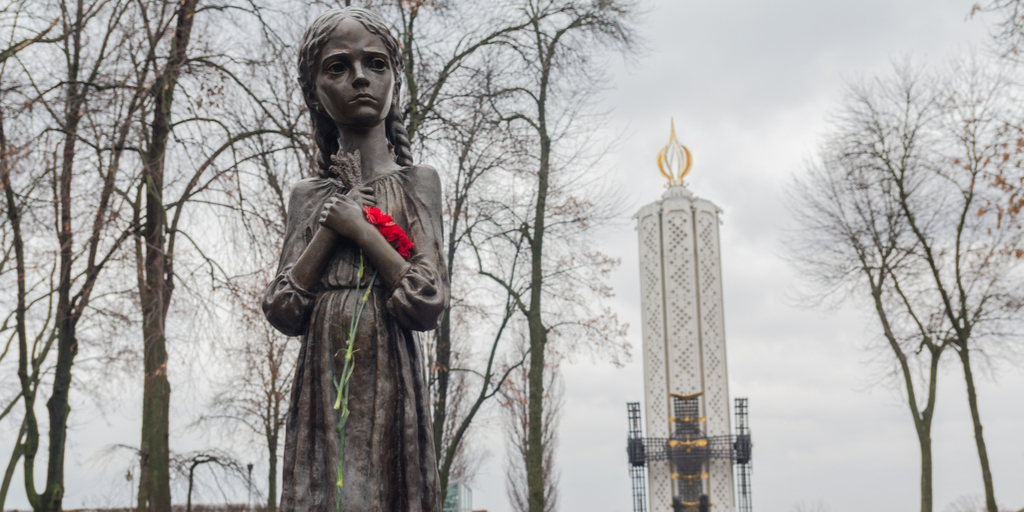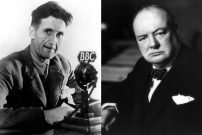In an age of postmodern hyper-individualism, Churchill and Orwell’s advocacy of individual liberty isn’t what is most interesting about them.
Thinking About the Holodomor: Part I
The Holodomor, or the Ukrainian Famine of 1932 and 1933, seems to contain within it the entire 20th century: large-scale suffering and death, endless cruelty, ideological fanaticism, political persecution, willful blindness, Western credulity, and lies as far as the eye can see. Although accounts of this entirely manmade catastrophe were available and widely published at the time, it was not until Robert Conquest’s The Harvest of Sorrow in 1986 that the Holodomor received the exhaustive and clear-eyed treatment it deserved.
Anne Applebaum’s recent book Red Famine: Stalin’s War on Ukraine covers much the same ground as Conquest’s but makes use of archival sources unavailable to him. Applebaum also argues that the famine itself is really only half the story. Closely related was an extensive attack on Ukrainian elites of any sort—artistic, intellectual, and political. It is both—the famine and the repression of the elites—that “brought about the Sovietization of Ukraine, the destruction of the Ukrainian national idea, and the neutering of any Ukrainian challenge to Soviet unity,” she writes.
Thus is this now 85-year-old event quite relevant to the politics of Russia and Ukraine today.
Blotting Out the Past
While the story of the Holodomor deserves telling and retelling, historical awareness of the terrors of 1932-33 was nearly effaced in the ensuing decades. The Soviet Union was quite adept at whitewashing these events and finding willing agents in the West to propagate lies on its behalf. Academic political scientists and historians, those supposedly well-equipped for measured analysis, have not always proven themselves to be reliable interpreters of the Holodomor. As the French philosopher and historian Alain Besançon put it, “It is characteristic of the twentieth century that its history was not only horrible in terms of human massacres, but that historical awareness . . . has had particular difficulty finding a true orientation.”
The British social scientists Sydney and Beatrice Webb visited the Soviet Union during the famine. Still they returned more convinced than ever that the Soviet system was a model for all to emulate. Here is their considered judgment, rendered in 1937, on “dekulakization” (the forced removal and deportation or murder of the supposedly wealthier peasants) during the collectivization campaign: “Candid students of the circumstances may not unwarrantably come to the conclusion that . . . the Soviet Government could hardly have acted otherwise than it did.”
Thankfully, not all “candid students” have come to that repellant conclusion. The reception of Applebaum’s book, which was published in 2017, has been favorable. Red Famine garnered very positive reviews in the New York Times, the Washington Post, Commentary, National Review, and The Guardian, the leftwing British newspaper. Even among scholars not inclined to agree with some of her conclusions, Applebaum, a longtime Washington Post columnist who is currently a visiting professor at the London School of Economics, seems to have earned a grudging respect. The Australian historian Sheila Fitzpatrick, writing in The Guardian on August 25, 2017, noted that Applebaum’s “take on Stalin’s intentions comes closer than I would to seeing him as specifically out to kill Ukrainians, but this is a legitimate difference of interpretation.”
That last admission is important, especially when one compares it with a prominent reaction, over three decades ago, to Conquest’s argument for the famine as an intentional plan. J. Arch Getty, a Soviet and Russia specialist at UCLA, wrung his hands about Harvest of Sorrow, saying it would “give a certain academic credibility to a theory which has not been generally accepted by non-partisan scholars outside the circles of exiled nationalities. In today’s conservative political climate, with its ‘evil empire’ discourse, I am sure the book will be very popular.” Note the sneering tone and attempt to place Conquest’s book beyond the pale of serious discourse.
Notwithstanding the progress shown by Fitzpatrick’s and others’ treatment of this subject, the debilitating thought patterns and dispositions that have been around for decades are unfortunately still evident. Sophie Pinkham, reviewing Red Famine for The Nation, argues that Applebaum’s history is distorted by her polemical intent and her anti-communism. Applebaum leaves the standards of academic history behind, says Pinkham, in her “frequent use of concepts of ‘evil’ and ‘morality’.”
This is the fact-value distinction at its most ludicrous, invoked in precisely the place, one would hope, that demonstrates its limits. As Pierre Manent once asked, “How can one begin to describe what goes on in a concentration camp without disclosing its inhumanity, that is, without evaluating it, without making a ‘value judgment’?”
Not surprisingly, Pinkham has trouble staying the value-free course. She identifies Applebaum’s broad “political agenda” (as revealed in the introduction to her Pulitzer Prize-winning 2003 book Gulag) as recognizing that “Stalinism—and, by extension, communism—was just as bad as Nazism.” Pinkham is clearly troubled by the comparison, as she is by what she sees as Applebaum’s “disgust at leftist sympathy for any part of communism at all.” This is a very old game: Isolate communism from Stalinism and its “excesses” so as to save the “good” parts of communism and thus discredit any parallels to Nazism.
Yes, the Two Totalitarianisms Are Comparable
Seeing the kinship between Nazism and communism has a long and distinguished history, stretching back to the 1930s and including luminaries of the 20th century like Alexander Wat, Czesław Miłosz, Waldemar Gurian, Eric Voegelin, Hannah Arendt, Raymond Aron, Vasily Grossman, and many others. I once asked the Czech novelist Ivan Klíma, who was in the Nazi transit camp Terezin as a child and then spent most of his life living under a communist regime, what he thought of the comparison between the two regimes. “In practice, there is no difference,” he told me. “The only difference is in the theory.”
Both regimes killed people in great numbers not for any action they took, but for who they were. But whereas Nazism proclaimed its racial ethic quite openly and its violence was inextricably intertwined with that ethic, communist atrocities were committed in the name of equality. Pressing Klíma to elaborate, I asked him what he thought of an argument put forward by Besançon, that precisely because of that contrast, it is communism that is the greater evil because it cloaks its evil, shrouds its violence in ideals familiar to people living in democracies. “I know this argument and I agree with it,” Klíma said.
It was the revisionist political scientists and historians of the 1960s and 1970s who were eager to jettison the concept of “totalitarianism” and thereby deny any kinship between Nazism and communism. These scholars were writing during the emergence of the postwar behaviorist social science revolution. They emphasized their “value-free” approach and subordinated politics to economics and social factors.
Modernization theory purported to explain Soviet behavior by arguing that the Soviet Union was simply trying to modernize and industrialize, but that it was doing so in a particular way that might be more suited to its economic, cultural, and historical circumstances. Institutional pluralists argued that the Soviet Union was a “polity” like any other, with multiple institutions—governmental and societal—interacting and struggling for control.
As indicated, Getty was typical of this kind of approach. Here’s how he began his review of The Harvest of Sorrow in the January 1987 issue of the of the London Review of Books: “In the 20th century a transformation-minded Bolshevik Party wrestled with peasant traditionalism, capitalism, low agricultural output and its own ideological preconceptions in an attempt to modernize along socialist lines.”
One would be hard-pressed to come up with a more insipid or anodyne description of Soviet communism. The phrase “modernize along socialist lines” rings with irony in a review that argues that Conquest failed to explain Stalin’s motive in perpetrating the terror-famine. It is as if the UCLA Sovietologist were recommending we look at it this way: “Yes, comrades, join me on this glorious path to modernization—one among many, of course—and once we iron out some bureaucratic inefficiencies and ideological excesses we shall eventually converge with our Western brothers!” To quote Martin Malia in a slightly different context, “Proper social science method could hardly obfuscate Soviet reality more thoroughly.”
That review, by the way, spawned a testy exchange between its author and Robert Conquest in the London Review of Books. Getty defended his narrow empirical approach and credited his own unwillingness to fall into “simple answers” and “sweeping assertions.” He also suggested that the work Conquest, the British author of over a dozen books on the Soviet Union, was political or partisan in much the same way that Markham would later call Applebaum’s book “polemical.”
The refuge of pseudo-objectivity is a tempting one, and it clearly allows the pseudo-objective a shocking level of self-deception. It also leads to a kind of self-importance that enables one to reject everything one deems lacking in methodological rigor or analytical neutrality. Of course the pseudo-objective fail to recognize the ways in which their own assumptions and categories do violence to the phenomena under examination.
As Applebaum notes in a brilliant chapter near the end of her book called “The Cover-Up,” scholars like Getty were very dismissive of first-hand journalistic accounts of the famine and the writings of emigrés who were lucky enough to survive and tell their stories. We will look at the some of these eye-witness accounts in subsequent posts.


